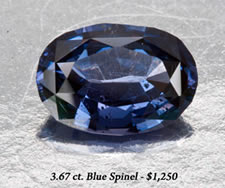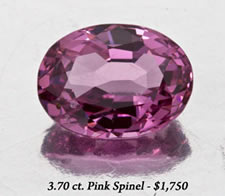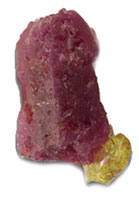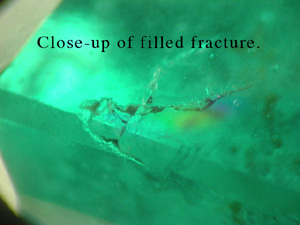 Spinel in the Spotlight
Spinel in the Spotlight
One of the most famous rubies in history is not ruby at all — it’s spinel.
Insurers: there’s a lesson here.
The 170-carat Black Prince’s ruby, centerpiece of the Imperial State Crown of England, is one of many famous “rubies” in crown jewels around the world that have turned out to be spinel. Ruby just means “red” after all, and until fairly recently that was enough to identify the gem.
It wasn’t until the late 18th century that scientists began to distinguish the two gems by their chemical makeup.
Today, as consumer interest in colored gems increases, spinel is finally being appreciated for the unique gem it is. Compared with other colored gems, including color-treated diamonds, clarity-treated rubies, and synthetic colored stones, spinel has a lot going for it.
Color
Spinel is found not only in red but in an array of colors, including blue, green, purple, orange, pink, and colorless. So it is a competitor not only with ruby but with colored stones in general, and with color-enhanced gems of all kinds, including diamonds. In earlier JII issues we’ve warned insurers about the limitations of color enhancement. (See, for example, Enhancing the Stone.)
Spinel occurs naturally in such a rich variety of color that color enhancements are not an issue.
Natural clarity
Here’s a big plus: spinel is typically clear and without inclusions of foreign material.
With diamond, ruby, and especially emerald, inclusions are common. Those stones are frequently subjected to clarity treatments, such as fracture filling, to conceal inclusions and improve the gems’ salability.
Insurers must always be on guard to be sure that such clarity treatments are disclosed, as these “enhancements” can drastically lower the gem’s value and can break down under certain conditions. We’ve reported in the past about some egregious treatments that can prove expensive for insurers and consumers.
For spinel, on the other hand, there are no known clarity treatments because the stone is by nature clear. Its integrity need never be compromised by fracture filling. This is a great advantage for both consumers and insurers.
Price
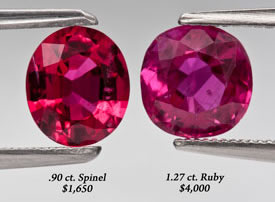 Spinel is actually more rare than ruby. In fact, it was too rare to even be used for jewelry until 2007, when new deposits discovered in Tanzania made spinel available in quantity.
Spinel is actually more rare than ruby. In fact, it was too rare to even be used for jewelry until 2007, when new deposits discovered in Tanzania made spinel available in quantity.
It still does not have ruby’s prestige, and right now that is to the buyer’s advantage. One gemologist who is an expert on this gem estimated that the price of spinel has gone up about 500% in the past four years. Even so, the price of the finest red spinel is about 50-90% below the price of the finest ruby.
Caveat for Insurers
So, because of the extreme difference in valuation, the major caution for insurers is not for spinel but for ruby:
Be sure that a stone called ruby on the appraisal is indeed ruby, not spinel.
Be sure the appraiser is knowledgeable and trustworthy. As usual, we recommend a detailed appraisal on JISO 78/79, written by a Certified Insurance Appraiser™ who has experience in handling colored gems.
FOR AGENTS & UNDERWRITERS
As colored gems become more popular, agents and underwriters need to be prepared for more variety in the jewelry they insure. In the current economy, many buyers are choosing less expensive stones that look like higher-priced gems.
For all high-value jewelry, be sure to get a detailed appraisal from an appraiser who is not the seller. Preferably it should be on JISO 78/79 form, written by a graduate gemologist who is also a Certified Insurance Appraiser™.
For any colored stones, it is essential that the appraisal be written by a gemologist experienced with colored gemstones and familiar with current pricing, treatments and frauds. Most jewelers deal primarily with diamonds, and even a trained gemologist may have little experience with colored stones.
Keep on file all documentation for scheduled jewelry, including the sales receipt.
FOR ADJUSTERS
Compare the sales receipt with the appraisal. If there is a great discrepancy between selling price and valuation, the selling price probably reflects value more accurately. If the sale price seems too low for the appraised value, it’s possible that the gem was fracture-filled, or was synthetic, or was a lower-value substitute, such as spinel passed off as ruby. A jewelry insurance expert may help in determining this.
If a claim is made for damage, ALWAYS have the damaged jewelry examined in a gem lab by a graduate gemologist, preferably one who is also a CIA. The exam
- will identify the gem;
- will verify the quality of the jewelry;
- may supply information missing from the appraisal;
- may reveal that the "damage" is not damage at all;
- may show the damage resulted from breakdown of fracture-fill material.
©2000-2025, JCRS Inland Marine Solutions, Inc. All Rights Reserved. www.jcrs.com

